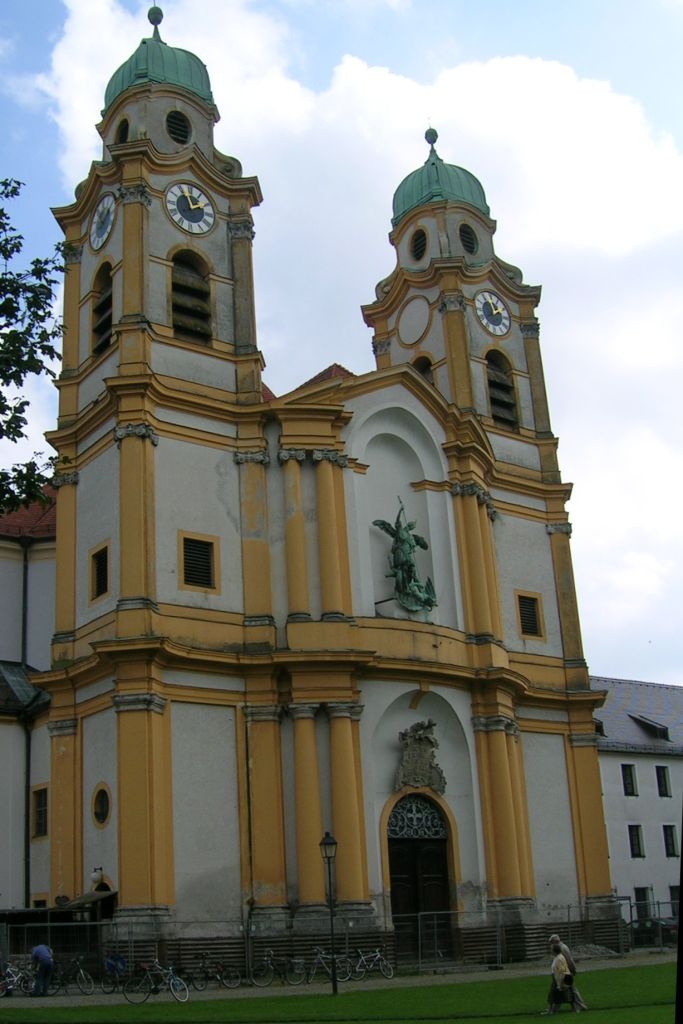St Michael in Berg am Laim (Munich) on:
[Wikipedia]
[Google]
[Amazon]
 St Michael in Berg am Laim is a church in
St Michael in Berg am Laim is a church in 
Warburg Institute Iconographic Database (images of the church interior)
{{DEFAULTSORT:Saint Michael in Berg am Laim, Munich Michael In Berg Am Laim Baroque architecture in Munich Baroque church buildings in Germany Churches completed in 1751 Registered historic buildings and monuments in Bavaria 1751 establishments in the Holy Roman Empire Tourist attractions in Munich Cultural heritage monuments in Munich
 St Michael in Berg am Laim is a church in
St Michael in Berg am Laim is a church in Munich
Munich ( ; german: München ; bar, Minga ) is the capital and most populous city of the German state of Bavaria. With a population of 1,558,395 inhabitants as of 31 July 2020, it is the third-largest city in Germany, after Berlin and Ha ...
, Bavaria
Bavaria ( ; ), officially the Free State of Bavaria (german: Freistaat Bayern, link=no ), is a state in the south-east of Germany. With an area of , Bavaria is the largest German state by land area, comprising roughly a fifth of the total lan ...
, built from 1738 to 1751 by Johann Michael Fischer
Johann Michael Fischer (18 February 1692 – 6 May 1766) was a German architect in the late Baroque period.
Fischer was born in Burglengenfeld, Upper Palatinate. He is a major representative of south German Baroque architects. He studied in Bohem ...
as Court Church for Elector and Archbishop Clemens August of Cologne
Cologne ( ; german: Köln ; ksh, Kölle ) is the largest city of the German western state of North Rhine-Westphalia (NRW) and the fourth-most populous city of Germany with 1.1 million inhabitants in the city proper and 3.6 millio ...
, a brother of Emperor Charles.
Clemens August owned Berg am Laim
Berg am Laim (Central Bavarian: ''Berg am Loam'') is a southeastern borough of Munich, Bavaria, Germany.
Notable landmarks
* Das Kartoffelmuseum
* Erzbruderschaft St. Michael
* Innsbrucker Ring
* Innsbrucker-Ring-Tunnel
* Kultfabrik
* Leuchtenb ...
as a manor. It was also served by the Military Order of Saint Michael until 1837 and by the ''Archbrotherhood of Saint Michael
Michael (; he, מִיכָאֵל, lit=Who is like El od, translit=Mīḵāʾēl; el, Μιχαήλ, translit=Mikhaḗl; la, Michahel; ar, ميخائيل ، مِيكَالَ ، ميكائيل, translit=Mīkāʾīl, Mīkāl, Mīkhāʾīl), also ...
''until today. The Catholic church is one of the chief works of the Bavarian rococo
Rococo (, also ), less commonly Roccoco or Late Baroque, is an exceptionally ornamental and theatrical style of architecture, art and decoration which combines asymmetry, scrolling curves, gilding, white and pastel colours, sculpted moulding, ...
period.

Architecture
The elegant façade with its twin towers provides a strong vertical accent was designed as the terminal feature of a street to the inner city which was never built. It is the only church of Fischer which was decorated in the rococo style with richrocaille
Rocaille ( , ) was a French style of exuberant decoration, with an abundance of curves, counter-curves, undulations and elements modeled on nature, that appeared in furniture and interior decoration during the early reign of Louis XV of France. ...
, maybe this was due to François de Cuvilliés
François de Cuvilliés, sometimes referred to as ''the Elder'' (23 October 1695, Soignies, Hainaut14 April 1768, Munich), was a Belgian-born Bavarian decorative designer and architect. He was instrumental in bringing the Rococo style to the Wi ...
the Elder, who served as a building inspector for this church.
Large round-headed arches divide the interior of the church in different sections. The central space is decorated by pilasters and columns and the corners are rounded off by several niches. The stucco and frescoes were created by Johann Baptist Zimmermann
Johann Baptist Zimmermann (3 January 1680, Gaispoint — 2 March 1758, Munich) was a German painter and a prime stucco plasterer during the Baroque.
Zimmermann was born in Gaispoint, Wessobrunn. He and his brother Dominikus Zimmermann were ...
in 1743, the altars were constructed by Johann Baptist Straub
Johann Baptist Straub (1 June 1704 (baptism) – 15 July 1784) was a German Rococo sculptor.
Biography
Straub was born in Wiesensteig, into a family of sculptors. His father Johann George Straub and his brothers Philipp Jakob, Joseph, and ...
.
The gilded figures on either side of the tabernacle are a contribution of Ignaz Günther
Ignaz Günther (22 November 1725 – 27 June 1775) was a German sculptor and woodcarver working in the Bavarian Rococo tradition.
He was born in Altmannstein, where he received his earliest training from his father, then studied in Munich und ...
. The painting of the high altar celebrating the archangel (by the Munich baroque painter Johann Andreas Wolff) and the statue of St. Roch (Andreas Faistenberger, 1690) were created already before the construction of the church. The altarpiece of the side altar St. Norbert was painted by Ignaz Joseph Schilling (1744/1746).
During World War II the church was heavily damaged on 30 April 1945 by artillery hit in the nave, but afterwards restored.
See also
*Saint Michael in the Catholic Church
Saint Michael the Archangel is referenced in the Old Testament and has been part of Christian teachings since the earliest times. In Catholic writings and traditions he acts as the defender of the Church and chief opponent of Satan, and assists p ...
References
External links
Warburg Institute Iconographic Database (images of the church interior)
{{DEFAULTSORT:Saint Michael in Berg am Laim, Munich Michael In Berg Am Laim Baroque architecture in Munich Baroque church buildings in Germany Churches completed in 1751 Registered historic buildings and monuments in Bavaria 1751 establishments in the Holy Roman Empire Tourist attractions in Munich Cultural heritage monuments in Munich